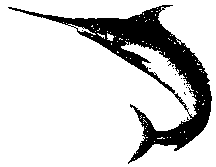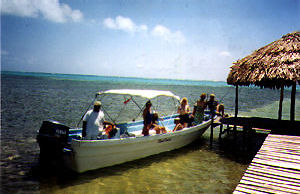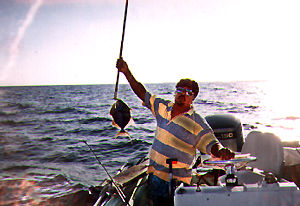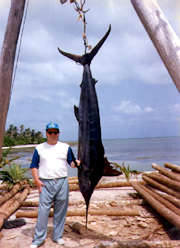ere is a list of general species and the times of the year they are most abundant
Bone Fish- All months
King Mackerel- April, May, and June
Sail Fish- Best in spring
Grouper- December - February
Barracuda- All months
Tarpon- All months
Marlin- All months
Wahoo- Winter best
Snapper- All months
|
Fishing in Belize- A First Experience
The tee-shirt says,"WHERE IN THE HELL IS BELIZE?" on the front an
"WHO THE HELL CARES !" on the back. And in 1982, I was one, who
like many, had no idea or gave a darn if Belize existed. After fishing
around the world, I was looking for a new and different place to soak a
bait and catch something different.
 A good fishing friend in King
Salmon
Arkansas suggested this small
Central American country. He
said he heard that the fishing was
great for tarpon, snook, and a variety of other salt
water species and suggested that I check it out. So, I
did!
A good fishing friend in King
Salmon
Arkansas suggested this small
Central American country. He
said he heard that the fishing was
great for tarpon, snook, and a variety of other salt
water species and suggested that I check it out. So, I
did!
I lucked out in San Francisco. I found a travel agent who
had been to Belize and told me the country was originally
called British Honduras, was located just south of Mexico
on the Atlantic Side, and was gifted with one of the
world's great barrier reefs. I purchased a ticket from
him and in January, 1982 headed to my next great fishing
paradise, Belize!
After a long and tiring flight from San Francisco, I found myself in
hot
and steamy Belize City. The airline had lost my baggage, so I was forced
to stay near the airport for at least a day. It soon become apparent
that
Belize City was not the port for my next great fishing adventure.
Although
the city is located at the mouth of a great river which empties
into the Caribbean Sea, pollution has ruined any chance of catching a
fish
in or around the City.

The next day my luggage arrived in Belize City and I was ready to
catch a fishl I asked the girl at the desk of my hotel where I might
expect
to catch a few fish in Belize and she suggested San Pedro. She also said
to look up Alan Forman at the Coral Beach Hotel since he really liked to
fish. Since then, I really wished I could find that woman to thank her.
Her suggestion started me on one of my greatest fishing adventures of
this life.
I then went to the local air taxi and booked a ticket to San Pedro, I
really didn't even know where it was but soon learned that it was on an
island north of Belize City and just south of Mexico. The town was
located on an island called Ambergris Caye, 29 miles north east ofthe
City, and just a few minutes from deep water and supposedly great salt
water fishing.
As the small plane left Belize City, I was immediately impressed at how
fast the water below us cleared. Within 5 miles, the water appeared
crystal clear with an occasional eagle ray swimming lazily along in
water
that appeared only a few feet deep. Then midway into the flight, I saw
the barrier reef
 and the great white waves breaking over it. Beyond the
reef was the deep blue water of the Atlantic and the big fish I had
heard
so much about... Then there was San Pedro, a town of maybe 2500
located right on the ocean with the barrier reef no more than 1/2 mile
from the town.
and the great white waves breaking over it. Beyond the
reef was the deep blue water of the Atlantic and the big fish I had
heard
so much about... Then there was San Pedro, a town of maybe 2500
located right on the ocean with the barrier reef no more than 1/2 mile
from the town.
After landing, I asked where the Coral Beach Hotel was located and
soon found myself checking in that hotel. Alan Forman greeted me with
a big smile and asked me what I liked to do. I told him I was here to
fish
and wanted to catch something really big! No sooner had I said that, he
saw someone walking past the hotel and hollered at this person, " Take
this guy fishing."
So, within an hour after my arrival in San Pedro, I was in a boat headed
for the reef and maybe my first big fish from Belizian waters.
 The reef which Belize advertises as the "world's second largest"
stretches along the entire country but is most obvious in the northern
part of the country. The reef starts in Mexican waters to the north and
snakes its way south about 1/2 mile from Ambergris Caye. At low tide,
parts are out of the water and even with low winds, there is enough
wave action to make the reef very obvious. Inside the reef, the waters
are shallow, averaging around 10 feet deep Outside the reef, the bottom
drops off fairly fast reaching 80 feet about 1/4 to a 1/2 mile and 400
feet
within a mile. Fortunately, there are some natural breaks which give
fishermen and divers access to these deeper waters.
The reef which Belize advertises as the "world's second largest"
stretches along the entire country but is most obvious in the northern
part of the country. The reef starts in Mexican waters to the north and
snakes its way south about 1/2 mile from Ambergris Caye. At low tide,
parts are out of the water and even with low winds, there is enough
wave action to make the reef very obvious. Inside the reef, the waters
are shallow, averaging around 10 feet deep Outside the reef, the bottom
drops off fairly fast reaching 80 feet about 1/4 to a 1/2 mile and 400
feet
within a mile. Fortunately, there are some natural breaks which give
fishermen and divers access to these deeper waters.
 Well. back to that first trip...
Well. back to that first trip...
There is a break in the reef directly in front of town, so we headed
for that. The guide said we need live bait, so we first trolled a plain yellow
jig and caught 3 or 4 yellow tail snappers about the size of your hand.
(Most boats engaged in fishing have live wells designed to keep a few
fish for bait. Most boats are locally built by master craftsmen from
Belizian mahogany). With the live snappers, we headed through the reef
and out to around 80 feet of water. (That's about the depth that you can
still see the bottom from the surface and generally marks the drop off to
the really deep waters).  The technique was simple. Hook the snapper with
a single hook through the snout followed by a treble hook toward the
back end of the bait (using wire leader) and turn the fish loose to swim
around in these beautiful blue waters. That day, like many to follow,
produced results within a few minutes. The first strike resulted in a snapper
cut in half just as clean as I could do with a sharp meat cleaver! What
was down there? The second yellow tail was quickly eaten by something
that really pulled and after fair battle, I landed my first barracuda - an
impressive silver and sleek predator with a mouth full of teeth rivaled only
by the northern pike or bull dog!
The technique was simple. Hook the snapper with
a single hook through the snout followed by a treble hook toward the
back end of the bait (using wire leader) and turn the fish loose to swim
around in these beautiful blue waters. That day, like many to follow,
produced results within a few minutes. The first strike resulted in a snapper
cut in half just as clean as I could do with a sharp meat cleaver! What
was down there? The second yellow tail was quickly eaten by something
that really pulled and after fair battle, I landed my first barracuda - an
impressive silver and sleek predator with a mouth full of teeth rivaled only
by the northern pike or bull dog!
After a couple more strikes and maybe another barracuda, we returned
to San Pedro and I headed happily back to the Coral Beach with my catch
in hand. Alan Forman filleted the fish and that evening, I enjoyed the
flavor of fried barracuda with the Forman family. It really looked like I
had found fishing paradise!
by Lou Gwartney
 A good fishing friend in King
Salmon
Arkansas suggested this small
Central American country. He
said he heard that the fishing was
great for tarpon, snook, and a variety of other salt
water species and suggested that I check it out. So, I
did!
A good fishing friend in King
Salmon
Arkansas suggested this small
Central American country. He
said he heard that the fishing was
great for tarpon, snook, and a variety of other salt
water species and suggested that I check it out. So, I
did!
 The reef which Belize advertises as the "world's second largest"
stretches along the entire country but is most obvious in the northern
part of the country. The reef starts in Mexican waters to the north and
snakes its way south about 1/2 mile from Ambergris Caye. At low tide,
parts are out of the water and even with low winds, there is enough
wave action to make the reef very obvious. Inside the reef, the waters
are shallow, averaging around 10 feet deep Outside the reef, the bottom
drops off fairly fast reaching 80 feet about 1/4 to a 1/2 mile and 400
feet
within a mile. Fortunately, there are some natural breaks which give
fishermen and divers access to these deeper waters.
The reef which Belize advertises as the "world's second largest"
stretches along the entire country but is most obvious in the northern
part of the country. The reef starts in Mexican waters to the north and
snakes its way south about 1/2 mile from Ambergris Caye. At low tide,
parts are out of the water and even with low winds, there is enough
wave action to make the reef very obvious. Inside the reef, the waters
are shallow, averaging around 10 feet deep Outside the reef, the bottom
drops off fairly fast reaching 80 feet about 1/4 to a 1/2 mile and 400
feet
within a mile. Fortunately, there are some natural breaks which give
fishermen and divers access to these deeper waters. Well. back to that first trip...
Well. back to that first trip... The technique was simple. Hook the snapper with
a single hook through the snout followed by a treble hook toward the
back end of the bait (using wire leader) and turn the fish loose to swim
around in these beautiful blue waters. That day, like many to follow,
produced results within a few minutes. The first strike resulted in a snapper
cut in half just as clean as I could do with a sharp meat cleaver! What
was down there? The second yellow tail was quickly eaten by something
that really pulled and after fair battle, I landed my first barracuda - an
impressive silver and sleek predator with a mouth full of teeth rivaled only
by the northern pike or bull dog!
The technique was simple. Hook the snapper with
a single hook through the snout followed by a treble hook toward the
back end of the bait (using wire leader) and turn the fish loose to swim
around in these beautiful blue waters. That day, like many to follow,
produced results within a few minutes. The first strike resulted in a snapper
cut in half just as clean as I could do with a sharp meat cleaver! What
was down there? The second yellow tail was quickly eaten by something
that really pulled and after fair battle, I landed my first barracuda - an
impressive silver and sleek predator with a mouth full of teeth rivaled only
by the northern pike or bull dog!
